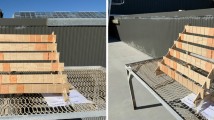Abstract
Iron oxide pigments may be an alternative treatment for limiting weathering of wood surfaces instead of stains or clear coatings. An earlier study suggested the ability of iron oxides to protect against discoloration varied with particle size. In this study, iron oxides with different crystal shapes and particle sizes were investigated along with a carbon black pigment. Loblolly pine (Pinus taeda L.) samples were impregnated with water borne iron oxide dispersions, exposed to predetermined amounts of solar radiation in the high desert of Eastern Oregon, and then evaluated for discoloration, checking and changes in chemical composition. The results from this observational study suggest that much higher levels of iron oxide are required than previously thought to prevent discoloration and limit lignin degradation. Large particle sizes led to greater opacity and provided greater protection, but no iron oxide protected as well as carbon black. The findings also suggested that iron oxides had no effect on checking, indicating that the mechanisms of discoloration and checking were not directly related.










Similar content being viewed by others
References
Black JM, Mraz EA (1974) Inorganic surface treatments for weather resistant natural finishes, US forest service research paper FPL 232. Research paper, US department of agriculture forest service, Madison, WI
Boeriu CG, Bravo D, Gosselink RJA, van Dam JEG (2004) Characterisation of structure-dependent functional properties of lignin with infrared spectroscopy. Ind Crops Prod 20:205–218
Christy AG, Senden TJ, Evans PD (2005) Automated measurement of checks at wood surfaces. Measurements 37:109–118
Coates J (2000) Interpretation of infrared spectra, a practical approach. In: Meyers RA (ed) Encyclopedia of analytical chemistry. Wiley, Chichester, pp 10815–10837
Endriss H (1998) Chapter 2 iron oxide pigments. Inorganic coloured pigments today. Vincentz, Hanover, pp 43–54
Evans PD, Chowdhury MJ, Mathews B, Schmalzl K, Ayer S, Kiguchi M, Kataoka Y (2002) Weathering and surface protection of wood. In: Kutz M (ed) Handbook of environmental degradation of materials. William Andrews, Norwich, pp 277–297
Faix O (1992) Fourier transformed infrared spectroscopy. In: Lin SY, Dence CW (eds) Methods in lignin chemistry. Springer, Berlin, pp 458–464
Feist WC, Hon DNS (1984) Chemistry and weathering and protection. In: Rowell RM (ed) The chemistry of solid wood. Advances in chemistry series 207. ACS, Washington, pp 349–370
Felder B (1971) Influence of particle geometry on optical properties of strong absorbing pigment particles. JCA 1(2):73–78
Funt JM, Sifleet WL, Tomme M (1993) Carbon black in plastics. In: Donnet J, Bansal R, Wang M (eds) Carbon black: science and technology. Marcel Deckker Inc., New York, pp 385–389
Gorman TM, Feist WC (1989) Chronicle of 65 years of wood finishing research at the Forest Products Laboratory, US forest service general technical report FPL 060 US department of agriculture forest service, Madison WI
ISO 11664: (2008) CIE Colorimetry––Part 4: 1976 L*a*b* Colour space. ISO/CIE, Geneva
Kiguchi M, Kataoka Y, Doi S, Mori M, Hasegawa M, Morita S, Kinjo M, Kadegaru Y, Imamura Y (1996) Evaluation of weathering resistance of the commercial pigmented stains by outdoor exposure in Japan. Mokuzai Gakkaishi 22(3):150–159
Kleive K (1986) Weathered wood surfaces-their influence on the durability of coating systems. J Coat Technol 58(740):39–43
Lanzalunga O, Bietti M (2000) Photo- and radiation chemical induced degradation of lignin model compounds. J Photochem Photobiol B Biol 56:85–108
Lewis PA (1995) Inorganic colored pigments. In: Koleske JV (ed) Paint and coating testing manual 14th edition of the Gardner–Sward handbook (ASTM manual series). ASTM, Philidephia, pp 209–217
Li G, Nicholas DD (2008) Mississippi State University, MS, personal communication.
Müller U, Rätzsch M, Schwanninger M, Steiner M, Zöbl H (2003) Yellowing and IR-changes of spruce wood as a result of UV-irradiation. J Photochem Photobiol B 69(2):97–105
Schauwecker C (2010) FTIR analysis of wood surfaces treated with prospective surface protestants and exposed outdoors for various exposure periods”. Evaluation of various chemical treatments to prevent the abiotic deterioration of southern pine surfaces through outdoor screening trials Ph.D. dissertation, Oregon State University. Corvallis, Oregon
Schauwecker CF, McDonald AG, Morrell JJ (2013) Performance of wood treated with prospective organic surface protectants upon outdoor exposure: FTIR spectroscopic analysis of weathered surfaces. Holzforschung 67(2):227–235
Schwanninger M, Rodrigues JC, Pereira H, Hinterstoisser B (2004) Effects of short-time vibratory ball milling on the shape of FT-IR spectra of wood and cellulose. Vib Spectrosc 36(2004):23–40
Schwertmann U, Cornell RM (2000) Chapter 3 Methods of characterization. Iron oxides in the laboratory preparation and characterization. Wiley, Weinheim, pp 27–53
Williams RS, Feist WC (1993) Durability of paint or solid-colored stain applied to preweathered wood. Forest Prod J 43(1):8–14
Williams RS, Feist WC (2001) Duration of wood preweathering: effect on the service life of subsequently applied paint. J Coat Technol 73(930):65–72
Wright P, McKenna MF (2000) Using transparent iron oxide pigments in wood finish applications. J Paint Coat Ind 16(11):44–54
Zivkovic V, Arnold M, Radmanovic K, Richter K, Turkulin H (2014) Spectral sensitivity in the photodegradation of fir wood (Abis alba Mill.) surfaces: colour changes in natural weathering. Wood Sci Technol 48:239–252
Acknowledgments
The authors would like to thank the Oregon State University Klamath Basin Research and Extension Center for their help during the field exposure portion of the study.
Author information
Authors and Affiliations
Corresponding author
Rights and permissions
About this article
Cite this article
Schauwecker, C.F., McDonald, A.G., Preston, A.F. et al. Use of iron oxides to influence the weathering characteristics of wood surfaces: a systematic survey of particle size, crystal shape and concentration. Eur. J. Wood Prod. 72, 669–680 (2014). https://doi.org/10.1007/s00107-014-0831-7
Received:
Published:
Issue Date:
DOI: https://doi.org/10.1007/s00107-014-0831-7




